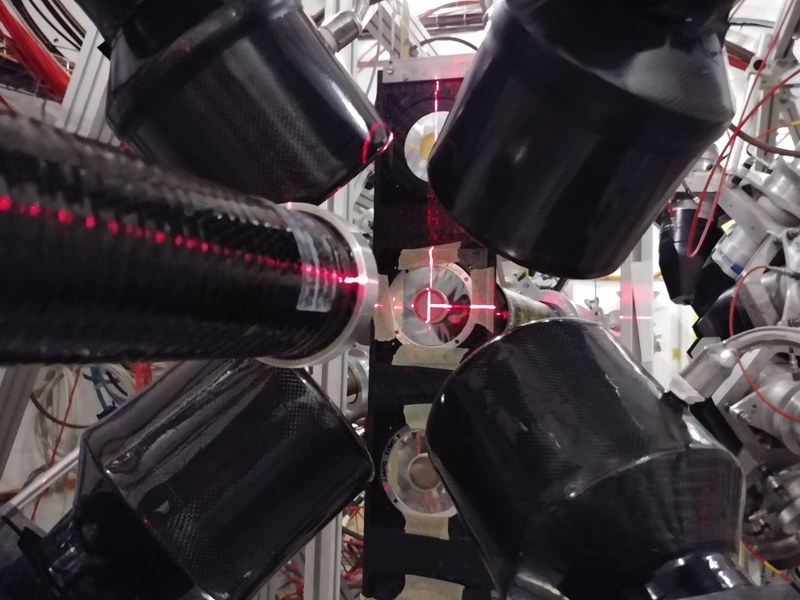Neutron capture cross section measurement of the heaviest s-process branching 204Tl and of 203Tl at CERN n_TOF
Oct 21, 2020
The thesis defense of Adrià Casanovas will take place next 27th October at 10h in the mark of the PhD programme Nuclear and Ionising Radiation Engineering Advisors: Dr. César Domingo / Dr. Francisco Calviño Virtual Room Meet: https://meet.google.com/ken-pmnp-quo
Neutron capture cross sections are fundamental in the study of the slow neutron capture process of nucleosynthesis, also known as the s-process, which produces half of the observed solar system abundances of elements heavier than iron.
Some nuclei along the nucleosynthesis chain are unstable, and there the capture process competes with the decay process, creating a split in the nucleosynthesis path. The nuclear properties of some of these radionuclides change with the conditions of the stellar environment, a fact that influences the local abundance pattern. 204Tl is a very interesting branching point, because it is shielded from any contribution from other nucleosynthesis processes. The result is that both 204Tl and its stable daughter isotope 204Pb are only produced by the s-process. Hence, by competing with the beta decay, the capture cross section of 204Tl crucially determines the final abundance of 204Pb. A faithful prediction of the solar abundances of s-only isotopes, like 204Pb, is one of the key accuracy tests for modern stellar nucleosynthesis calculations.
However, until the present work, due to the challenges of performing a capture measurement on 204Tl, there was no experimental data of its cross section. Thus, large uncertainties existed in its capture cross section, which hampered a more accurate and precise knowledge of the predicted s-process production of 204Pb.
By affecting the abundance of 204Pb, the cross section of 204Tl(n,γ) also influences the ratio of abundances 205Pb/204Pb. 205Pb is also produced only by the s-process, and it is radioactive, with a long half-life of 17.2 My. Therefore, the ratio of abundances of 205Pb/204Pb has the potential to be used as a chronometer of the s-process.
In the year 2013, a sample enriched up to a few percent in 204Tl was produced by neutron irradiation of a 203Tl seed sample at the high thermal neutron flux nuclear reactor of the ILL, in Grenoble (France). Two years later, the 204Tl enriched sample was employed to measure, for the first time, the capture cross section of 204Tl at the n TOF time-of-flight facility at CERN. The measurement was possible thanks to the unique features of this facility, in particular, its high instant neutron flux low background levels. The measurement was performed employing the well-established total energy detection technique (TED), which offers a very low neutron sensibility, and low levels of background, compared to other methods like the Total Absorption technique.
The main challenges for the 204Tl measurement were the very high background due to the activity of the sample, the very low amount of material, and the limited knowledge of the geometry of the sample. Such difficulties required the adoption of specific solutions during the measurement and the posterior data analysis. Related to this, several sources of systematic error were evaluated by means of Monte Carlo simulations.
The complications with the 204Tl sample geometry required to apply an in-sample normalization procedure. For this purpose, an ancillary capture measurement on a 203Tl sample was also performed in the same experimental campaign. As a stable nuclide, most of the sources of systematic error could be kept under control. This allowed for an accurate R-matrix analysis of the most relevant capture levels in the resolved resonance region of 203Tl, including the first ever measurement under 3 keV of neutron energy. As a result, the present work has contributed, as well, to improve the 203Tl stellar capture cross section in the 8 to 25 keV neutron energy range.
With the improved 203Tl(n,γ) cross section, an R-matrix analysis of several 204Tl resonances was made possible. These results were employed to experimentally constrain the 204Tl stellar cross section at low energies, and setting additional limits to the stellar cross section predicted by nuclear data evaluations at s-process temperatures.

Share: